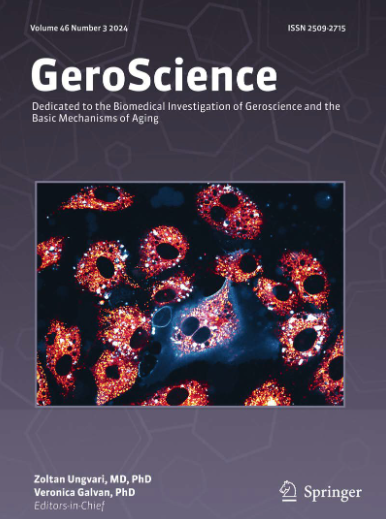表型年龄加速作为良性前列腺增生的新预测因子:一项前瞻性队列研究。
IF 5.4
2区 医学
Q1 GERIATRICS & GERONTOLOGY
引用次数: 0
摘要
本研究旨在探讨联合表型年龄和表型年龄加速(PhenoAgeAccel)对良性前列腺增生(BPH)的预测价值,并开发基于机器学习的风险预测模型,为精准预防和临床管理策略提供信息。该研究分析了美国国家健康与营养调查(NHANES, 2001-2008)中784名男性参与者的数据。表型年龄来源于实足年龄和9个血清生物标志物。表现型年龄对实足年龄的残差,表示生物衰老加速。递归特征消除(RFE)识别了34个bp相关特征,并将其集成到XGBoost预测模型中。逻辑回归评估了PhenoAgeAccel-BPH的相关性,而SHapley加性解释(SHAP)量化了特征贡献,以提高模型的可解释性。XGBoost模型在测试集中的曲线下面积(AUC)为0.833。表型年龄与实足年龄密切相关(r = 0.833),携带表型加速的个体患BPH的风险显著升高(p < 0.001)。用表型年龄调整模型可提高预测性能(AUC = 0.853)。SHAP分析将表型年龄确定为第三大影响因素(仅次于癌症史和铅暴露),突出了其临床相关性。实足年龄和血清生物标志物是BPH的关键预测因素,而PhenoAgeAccel独立地有助于风险分层。将表型年龄与机器学习相结合,为BPH的早期检测和个性化风险评估提供了一个强大的框架,与衰老生物标志物研究的进展保持一致。这种方法支持有针对性的干预措施,以减轻老年人群中前列腺增生的进展。本文章由计算机程序翻译,如有差异,请以英文原文为准。
Phenotypic age acceleration as a novel predictor of benign prostatic hyperplasia: a prospective cohort study.
This study aims to investigate the predictive value of combined phenotypic age and phenotypic age acceleration (PhenoAgeAccel) for benign prostatic hyperplasia (BPH) and develop a machine learning-based risk prediction model to inform precision prevention and clinical management strategies. The study analyzed data from 784 male participants in the US National Health and Nutrition Examination Survey (NHANES, 2001-2008). Phenotypic age was derived from chronological age and nine serum biomarkers. PhenoAgeAccel, representing biological aging acceleration, was calculated as the residual from regressing phenotypic age on chronological age. Recursive Feature Elimination (RFE) identified 34 BPH-associated features, which were integrated into an XGBoost prediction model. Logistic regression evaluated PhenoAgeAccel-BPH associations, while SHapley Additive exPlanations (SHAP) quantified feature contributions to enhance model interpretability. The XGBoost model achieved an area under the curve (AUC) of 0.833 in the test set. Phenotypic age was strongly correlated with chronological age (r = 0.833), and individuals with PhenoAgeAccel exhibited a significantly elevated risk of BPH (p < 0.001). Adjusting the model with phenotypic age improved predictive performance (AUC = 0.853). SHAP analysis identified phenotypic age as the third most influential predictor (after trailing cancer history and lead exposure), highlighting its clinical relevance. Chronological age and serum biomarkers are critical predictors of BPH, while PhenoAgeAccel independently contributes to risk stratification. Integrating phenotypic age with machine learning provides a robust framework for the early detection of BPH and personalized risk assessment, aligning with advancements in aging biomarker research. This approach supports targeted interventions to mitigate BPH progression in aging populations.
求助全文
通过发布文献求助,成功后即可免费获取论文全文。
去求助
来源期刊

GeroScience
Medicine-Complementary and Alternative Medicine
CiteScore
10.50
自引率
5.40%
发文量
182
期刊介绍:
GeroScience is a bi-monthly, international, peer-reviewed journal that publishes articles related to research in the biology of aging and research on biomedical applications that impact aging. The scope of articles to be considered include evolutionary biology, biophysics, genetics, genomics, proteomics, molecular biology, cell biology, biochemistry, endocrinology, immunology, physiology, pharmacology, neuroscience, and psychology.
 求助内容:
求助内容: 应助结果提醒方式:
应助结果提醒方式:


